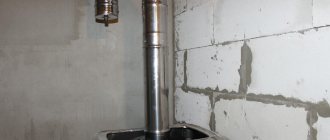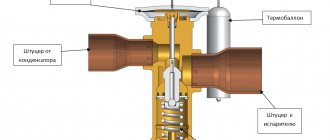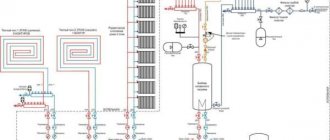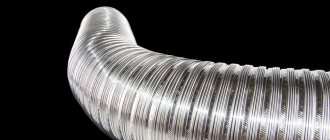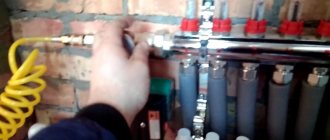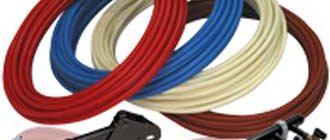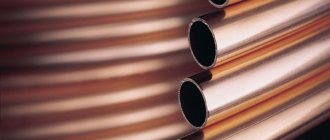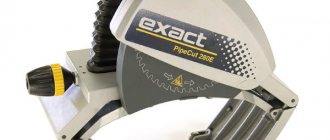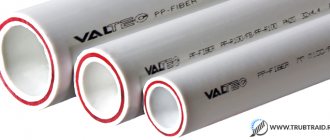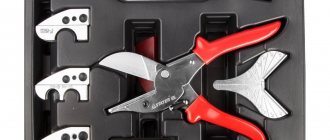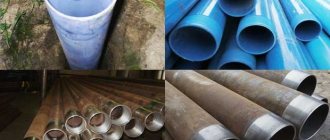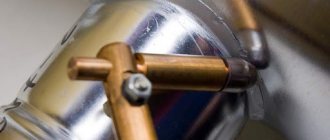The chimney is considered one of the most complex roof components in terms of design. The product must be sealed using a modern, reliable chimney seal. To isolate smoke exhaust channels, asbestos, roofing felt, cement and bitumen solutions are used. But more and more dacha owners prefer the elastic “Master Flash”.
What to consider during work?
Finishing smoke exhaust ducts involves creating a flashing or apron from rectangular sheets of metal. The width of the products is 40 cm, and the length corresponds to the size of the pipe. The plates need to be bent, focusing on the angle of movement of the smoke. To calculate the length of the finish, it is worth considering:
- chimney size;
- the angle that the slope has;
- type of roofing.
Tiled roofs or structures covered with corrugated sheeting are connected using the standing seam technique. Pitched roof structures require a special “side” made of wooden beams, which prevents exposure to weather factors.
Areas of application for Master Flash penetrations:
Straight - for roofs made of corrugated sheets, metal tiles, flat, membrane, roll, bitumen roofing. Combi - for roofs made of corrugated sheets, metal tiles, standing seam roofing. Corner - for roofs made of flexible, ceramic, slate tiles, composite materials, ondulin, slate. Pro - for roofs made of corrugated sheets, metal tiles and slate roofs. Ultra-angle - for roofs made of corrugated sheets, metal tiles and slate roofs.
Traditional sealing materials
When purchasing a chimney lining, you should focus on the type of material from which the chimney is made. Experts advise working:
- roofing bricks. Durable boards are resistant to temperature fluctuations and the influence of aggressive environments. Solid bricks are laid on a cement mass, and the seams are treated with grout;
- clinker tiles. The tiles are lightweight, which is ideal for tall chimney structures;
- plaster. The inexpensive cost of the mixture makes it accessible for construction work on a small budget. The loose texture of the composition requires reinforcement with a cement screed or cement-lime paste. Additionally, the applied and dried mass is coated with silicone compounds;
- slabs made of cement fibers. Small plates are characterized by strength, resistance to ultraviolet radiation and climate change. Eco-friendly, non-flammable material with a smooth or structured texture due to its low weight is easy to install;
- slate. The natural material is suitable for cladding the roof or chimney. In addition to sealing, rectangular, flake or octagonal panels create an attractive pipe decor.
When choosing the type of material for self-sealing, give preference to steel sheets - they are characterized by strength, ductility and ease of use.
Features of making a steel apron
A steel apron is applied to a plank roofing deck covered with liquid or sheet roofing felt. Measures to organize compaction include:
- bending the edges of the apron onto the walls of the chimney structure;
- laying timber sheathing at the beginning and end of the pipe;
- placing tiles on top of the sheathing;
- cutting a groove on the wall of the pipe - the upper part of the apron is placed in it;
- fastening steel frame elements to pipe walls. They start working from below;
- filling the grooves with the upper part of the apron with roofing silicone or a special sealant.
It is recommended to seal the roof hole when installing a chimney.
Roll insulation
To seal large-diameter and square-shaped pipes, roll insulation reinforced with aluminum strip is produced. It has its own installation nuances:
- the material must be cut 30 cm larger than the diameter of the chimney in order to secure it with an overlap;
- when gluing the insulation, it is necessary to bend it so that the edge extends onto the chimney to a height of about 5 cm;
- After finishing the formation of the edges of the rolled insulation, it is necessary to secure it with a special silicone glue. The fasteners are reinforced with small screws.
After fixing the insulation, it can be painted in the color of the roofing sheet. The speed of construction is ensured by innovative material - “Master Flash”. Special penetrations made of elastic rubber are characterized by a long service life and resistance to aggressive environments.
Aluminum corrugation for chimneys
Aluminum alloys used in the production of this type of product can withstand temperatures up to 500 degrees, after which the thin walls of these pipes burn out.
But not only temperature is important, but also the aggressive environment represented by condensate, which is a weak solution of sulfuric acid. In this regard, it is obvious that their use for this purpose is very limited. It is not recommended to install corrugation on the chimneys of solid fuel boilers, where the temperature of the furnace gases is much higher and high-temperature means are used to remove soot from the chimney. Corrugation is not used for fireplaces and solid fuel stoves burning coal and wood.
Aluminum corrugated chimneys for gas boilers are still used quite actively, but gas and fire service specialists are increasingly inclined to ban such structures.
Watch the video
Laminate stove and aluminum corrugation
A more loyal attitude towards corrugation for the chimneys of gas water heaters and electric fireplaces, since the temperature of the exhaust gases is lower than that of similar boilers.
Stainless steel corrugation
Heat-resistant corrugation is made from stainless steel using the same technology as aluminum.
These pipes use a high carbon steel reinforcing insert, wound in the form of a spring. The spiral in the chimney increases the lateral strength of the products and protects them from collapse. One of the features of corrugated products is their compactness. In the transport position, the length of the pipe is 65 centimeters, and after stretching along the longitudinal axis it can reach three meters.
Watch the video
Corrugated stainless steel advantages and disadvantages
The temperature that heat-resistant stainless steel corrugation can withstand is 900 degrees, which allows you to confidently use it for chimneys with any type of boiler.
Pipes are produced in a diameter range from 100 to 150 millimeters, the most used sizes being 110 and 130. The former are used to install chimneys for boilers up to 19 kilowatts; larger ones can be used for any more powerful heating units.
During installation, the corrugated pipe can be bent in the desired direction at an angle of up to 180 degrees, which is a definite advantage, since it allows you to do without the use of a large number of fittings.
To increase service life, stainless steel is treated from the inside with special compounds. By reacting with the metal, they form a durable, chemically resistant cladding film on the surface. In this condition, a corrugated chimney can last up to 20 years. Fireproof corrugation is the most reliable material for smoke removal.
Installation instructions
Installing a chimney is not much different from installing a similar device made of stainless pipes. But there are certain points that need to be taken into account:
- There is no need to think about selecting the diameter of the chimney - the corrugated pipe must correspond to the size of the boiler outlet pipe.
- Having a thin wall, the corrugation loses a large amount of heat from the flue gases. Therefore, the chimney must be insulated along its entire length (except for the outlet pipe).
- Narrowing of the smoke channel is not allowed; its size must be stable along its entire length.
- During the installation process, only adapters for special purposes should be used. The use of other products for joining is fraught with loss of tightness, and this is the main requirement for a chimney.
- The use of corrugation requires the mandatory installation of a condensate collector, otherwise its rapid planting is inevitable.
- When connecting individual parts of the chimney, in addition to clamps, additional seals must be installed. Good results are achieved by using a high-temperature sealant.
Using these rules, you can efficiently install an effective, and - most importantly - safe in all respects, chimney.
Tips and tricks
- It is undesirable to use aluminum corrugated pipes for chimneys of solid fuel boilers. And for gas appliances, including a water heater, it is better to avoid the risk and use fire-resistant stainless steel. Gas corrugation is fire hazardous.
- If the corrugation is discharged outside through a brick chimney, assembly is done from above. In this case, a strong rope is tied at the lower end. In this way, working together, you can quickly and easily line the chimney with corrugation. A flexible stainless steel chimney is fed through the mouth of the pipe, and the second participant in the process pulls up the corrugation from below.
- When installing an external (wall) chimney, more than two bends are not allowed. If necessary, it is better to perform them at an angle of 45 degrees.
- When installing a steel corrugation for a boiler in an old chimney, you need to carefully cover the stove with a wet sheet and close all the technological holes in it. This is necessary to prevent soot from entering the living space of the house.
- Before installing the pipe in an old chimney, it is necessary to thoroughly clean it of soot deposits on the walls.
"Master Flash" - a new word in chimney sealing
“Master Flash” is an elastic seal that seals the joints of the chimney and roofing material. It is a rigid base made of silicone or rubber with rings of different diameters in the upper part. To strengthen the product, an aluminum gasket is used.
Difference between rubber and silicone materials
The chimney cover has the shape of a cone and an angle of inclination depending on the roof slope. Cones with an angle of 90º are used for flat roofs. The pitched roof covering is sealed with a roof with the rings protruding at 45-30º. Silicone or EDPM rubber is used to make the seal. The raw materials differ in their qualities:
- Silicone cones are more elastic. When exposed to temperatures up to 315 ºС, they are destroyed under the influence of ultraviolet radiation;
- rubber melts at temperatures above 185 ºС, but is resistant to ultraviolet radiation.
The cost of the “Master Flash” design is affected by the material and diameter of the product.
Material advantages
The modern design for sealing the chimney has a number of advantages:
- elasticity, which ensures a tight fit of the pipe to the material;
- resistance to temperature changes, which is especially good in regions with harsh climates;
- fire resistance (preservation of its qualities at temperatures of 185 – 315 ºС depending on the type of material);
- long service life - about 30 years;
- does not require special skills, effort or specific tools for installation;
- can be installed at any time of the year.
The use of the Master Flash sealing structure eliminates the need for additional use of sealing materials.
Installation of corrugations for a chimney
The assembly of this simple structure must be done in the following order:
- Choose a location for the heating unit so that the chimney is straight and vertical. This means that along its path the chimney should not encounter any obstacles that must be bypassed. This mainly concerns transfers on the interfloor ceiling and rafter system.
- Install the elbow at the outlet of the boiler or gas water heater. Instead, flexible corrugation made of aluminum or stainless steel can be used. It should be noted that this area is almost never insulated from the outside, since the temperature of the furnace gases in this place is high and condensation does not form.
- Next, the straight section is installed with the installation of clamps and fastening to brackets (for a wall-mounted chimney).
- It is advisable to make the outer part, rising above the roof, from an insulated sandwich pipe; if necessary, install guy wires made of stainless or galvanized wire.
- Install a safety device in the form of a cap on the pipe.
- Install a condensate trap.
Important! To ensure that condensate is collected and prevented from getting back into the firebox, the vertical part of the chimney cannot be placed directly above it.
Installation Features
A modern type of seal does not require specific knowledge in the field of construction; it is enough to follow the installation instructions:
- The top of the rubber cone should be 20% smaller than the diameter of the pipe, so if there is excess, it needs to be trimmed (for convenience, you can use scissors with a hooked end);
- Installation is carried out by pulling the structure onto the pipe. To make it easier to move along the chimney, it is recommended to moisten the cone with water or lubricate it with soap. You should pull while holding the top to avoid deformation of the base.
- The base, reinforced with aluminum sheet, is inserted under the nearby edge of the roofing to prevent moisture from entering the structure;
- The junction of the upper edge of the rubber cone with the pipe must be thoroughly coated with sealing compounds for additional strengthening. Instead, you can use a metal clamp.
For additional fixation of the structure, you can screw the base to the roof, using rubber washers to seal the holes. After installation, the device remains movable, which gives an advantage when the pipe expands during the heating process.
Advantages and disadvantages of corrugated chimney pipes
The positive aspects of using corrugation for such purposes include the following points:
- The chimney cross-section in the form of a circle is the most favorable for the passage of gases. The flow rises along it in a spiral, due to which stagnant zones are created in the corners of the square or rectangular channel, in which the moisture present in the smoke actively condenses. It becomes a “trap” for unburned fine particles of fuel. This mixture becomes soot, which can completely block the smoke channel, making further operation of the heating unit in the house impossible.
- Simple joining of individual elements of the chimney pipe. All you need is a simple adapter and a couple of clamps.
- Simple and affordable repairs involving simple dismantling and easy assembly of a new smoke duct.
- The need for various components is minimal, since corners, turns and other similar elements are not used.
- Convenience of laying a chimney with changes in direction if you need to bypass obstacles in the form of rafters and other structural elements.
However, there are several negative aspects of their use:
- Small wall thickness (0.1 mm), which leads to active cooling of the chimney and is accompanied by the formation of a large amount of condensate, and therefore soot. A smoke duct made of heat-resistant corrugation requires careful and high-quality insulation.
- The unevenness of the inner surface of the corrugation walls, which contributes to increased formation of condensation and soot.
Most often, corrugated pipes are used to install liners in brick or other channels in the shape of a rectangle,
as well as in the places where the boiler is connected to the smoke exhaust duct.
Selecting a seal
To choose the right modern roofing seal for the Master Flash chimney, you must be guided by the following data:
- To seal a chimney located on a pitched roof with a slope of 10-45 degrees and covered with roofing steel, bitumen shingles, and plastic, sealing structures with a flexible square or round base are used.
- in the case of a roof slope from 45 to 60 degrees, seals with a reinforcing strip of aluminum are used.
- if the roof slope is more than 60 degrees, “Master Flash” models with an increased base area are installed. Such structures are also mounted on roofs covered with slate or tiles.
- When installing, it is worth considering the physical properties of silicone and rubber. Silicone structures are completely resistant to any changes in temperature, unlike ethyl-propylene rubber, which has an upper limit of tolerance to high temperatures of +140 degrees.
For cases where it is not possible to put a sealing structure on top of the chimney, models with a side lock have been developed. Roofing using Master Flush seal around the chimney provides reliable protection against water leakage into the pipe openings. It is possible to install modern insulating material yourself, without the involvement of specialists.
0 0 vote
Article rating
Design and types of corrugated pipes for chimneys
Corrugated pipes for chimneys are produced by cold molding on a special mandrel. For this purpose, two types of materials are used: aluminum-based alloys and stainless steel.
The workpiece is a tape about 50 millimeters wide with a thickness of 0.1 - 0.5 millimeters.
Initially, corrugation was intended for use on air ducts of ventilation systems , where to this day it does its job properly.
Attempts to use such pipes for chimneys were successful, and since then this application has become increasingly popular.
Installation of corrugations for a geyser
Using corrugation for the chimney of a gas boiler is a completely justified decision, taking into account the cost and positive aspects - this is the best option than laying a solid structure, which will also require a foundation and more significant repairs. Despite the fact that in the column itself the temperature can reach about 2000 degrees, in the channel itself this figure will rarely exceed 200. Therefore, a flexible chimney is quite safe in this case, and you don’t have to worry about the fire hazard.
Before installing corrugation, check the possibility of application in your particular apartment or house. To do this, check the dimensions and cross-section of the pipes in the technical documents; it is strictly forbidden to use a smaller diameter. If a smaller section is used, over time the structure will lose strength, shape, and tightness. In addition, breakdowns will occur in the boiler itself due to insufficient smoke emission. In addition, keep in mind that the length of the corrugation should not be more than 3 meters.
We hope this article helped you, we would be grateful if you share it with us on social media. networks.
